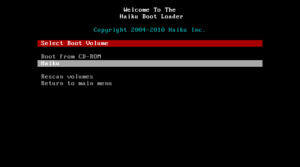Bootmanager
BootManager, formerly known as BootMan, is the Haiku[3] and BeOS boot loader[4] on x86 systems. It resides solely in the master boot record and does not require installing Haiku or BeOS, although it must be installed from Haiku or BeOS. Its BeOS predecessor was BootMan, and was later renamed as BootManager by the Haiku project.
 | |
| Written in | Assembly language |
|---|---|
| Operating system | BeOS like,[1] Haiku [2] |
| Type | Boot loader on x86 |
| License | MIT |
It is filesystem agnostic, and boots an operating system as if it were being booted directly from the hardware. As such, it can boot virtually any operating system. It can also chainload GRUB, LILO and NTLDR. However, being independent of an OS prevents it from being able to boot any disks which are not accessible via BIOS I/O routines (e.g. INT 13H), with the exception of BeOS disk-in-a-file images on FAT32, NTFS or ext2 file systems.
Configuration[3]
In Haiku, BootManager exists in "/boot/system/apps/BootManager".[5]
Steps:[3]
1. Launch the Installer application and select Set up boot menu from the Tools menu.
2. Select the drive on which you want to install BootManager to
3. Click on the Install button
4. Leave the default MBR save location alone (this lets you use the defaults if you need to Uninstall), and click the Next button.
5. Click Next
6. Choose the partition in which you have installed operating systems and name them. Hit Next
7. Draw to adjust the timeout and select the default OS that loads when the timeout finishes.
8. Click Next
Congratulations, you have successfully configured BootManager on your system.
History
Bootman appeared in BeOS R4.0, replacing LILO, which was used in R3.x. Installing, configuring, and uninstalling can be done solely by a graphical application, also called Bootman. This can also create an MBR restoration floppy disk without modifying the current MBR. In Haiku Alpha 3, Bootman was rewritten and renamed to BootManager.[4]